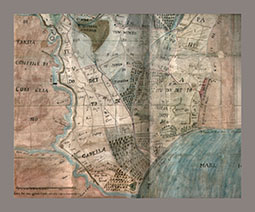Author: C. Colelli
Download article as .pdf: Un mito nella palude: “Non bisognava esplorare il deserto di Sahara per trovare Sibari”
 At the end of the 8th century BC Greek people from Achaia founded Sybaris in the alluvial plain between the courses of the Sybaris and Krathis rivers. The city became a symbol of luxury and richness among the ancients before being destroyed in 510 BC. The Panhellenic Thurii (444 BC) and the Latin colony of Copia (194 BC) were then founded in the same place. After the fall of Roman Empire, the plain, once famous for its fertility, became unhealthy and swampy: Copia was abandoned and its buildings covered by water and mud. During long centuries of oblivion, the area became an immense swamp, the rivers changed their course several times. Water and mud covered the ruins and only the memory of the three cities remained. In the eighteenth century, just near the mouth of the two rivers, ancient vestiges were visible that historians, geographers and travelers of the Grand Tour had no doubts believe the ruins of Sybaris. After the unification of Italy, a large and expensive research program began through which archaeologist tried, in vain, to uncover the remains of the ancient polis. Only in 1932, after the reclamation of the plain, Umberto Zanotti Bianco, an intellectual disliked by the Fascist regime, was able to identify, in the area now known as Parco del Cavallo, the remains of Copia built on the place already occupied by Thurii and Sybaris.
At the end of the 8th century BC Greek people from Achaia founded Sybaris in the alluvial plain between the courses of the Sybaris and Krathis rivers. The city became a symbol of luxury and richness among the ancients before being destroyed in 510 BC. The Panhellenic Thurii (444 BC) and the Latin colony of Copia (194 BC) were then founded in the same place. After the fall of Roman Empire, the plain, once famous for its fertility, became unhealthy and swampy: Copia was abandoned and its buildings covered by water and mud. During long centuries of oblivion, the area became an immense swamp, the rivers changed their course several times. Water and mud covered the ruins and only the memory of the three cities remained. In the eighteenth century, just near the mouth of the two rivers, ancient vestiges were visible that historians, geographers and travelers of the Grand Tour had no doubts believe the ruins of Sybaris. After the unification of Italy, a large and expensive research program began through which archaeologist tried, in vain, to uncover the remains of the ancient polis. Only in 1932, after the reclamation of the plain, Umberto Zanotti Bianco, an intellectual disliked by the Fascist regime, was able to identify, in the area now known as Parco del Cavallo, the remains of Copia built on the place already occupied by Thurii and Sybaris.
